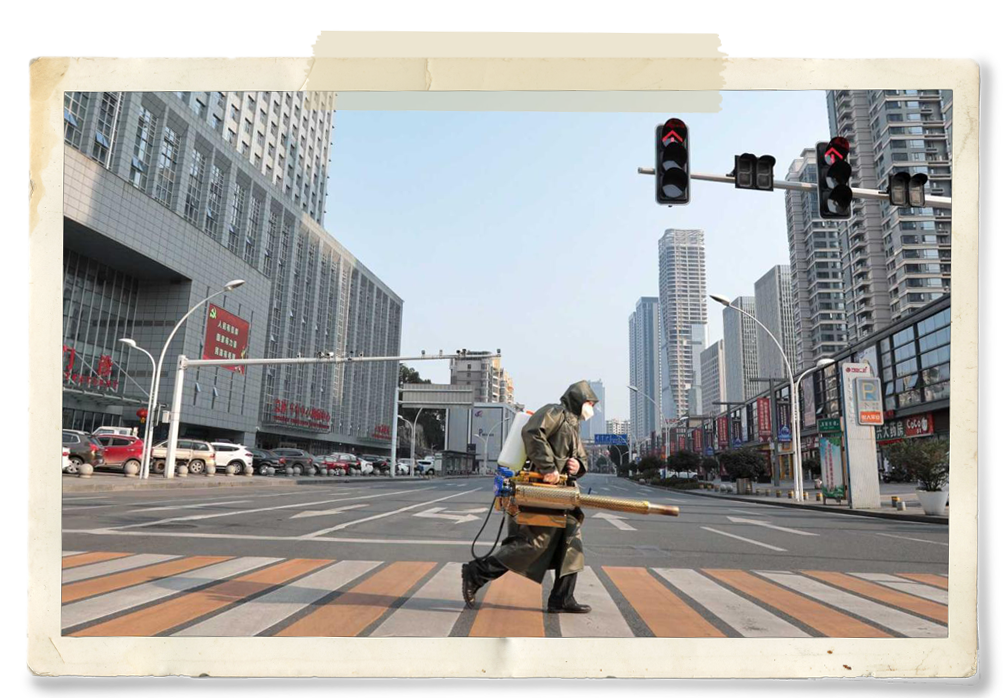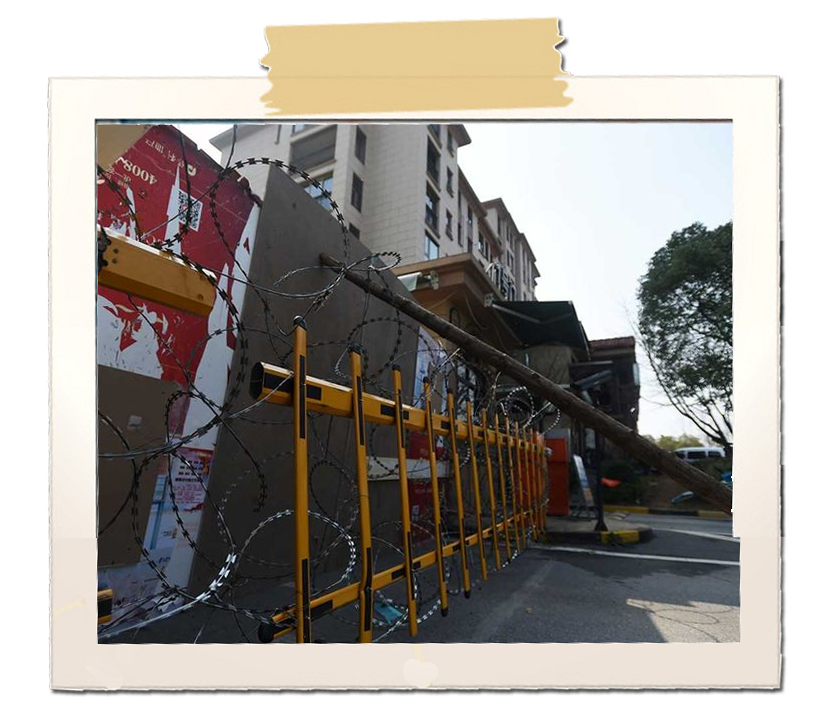Hubei Province lockdown
On January 23, 2020, China imposed a lockdown in Wuhan which was eventually extended to all 15 cities in Hubei province, covering about 57 million people.

AFP
A worker with disinfecting equipment crosses the road in front of a hospital in Yichang city of Hubei, on February 12, 2020.
Atypical pneumonia — with acute respiratory distress syndrome — became the signature of the “Wuhan virus”, later called 2019 novel coronavirus (nCoV), later renamed SARS-CoV-2, the virus that caused COVID-19.
Nobody knew initially how transmissible the disease was.
Western observers, including Amnesty International, were uncertain about the Chinese lockdowns. But, as the COVID-19 pandemic spread far and wide, similar measures were taken around the globe.

Reuters
Barbed wire is seen on an entrance to a residential compound in Wuhan, in February 2020.
The WHO, stating that it was beyond its guidelines, praised the move, calling it “unprecedented in public health history”.
The Wuhan lockdown became a precedent for similar measures in other Chinese cities. Within hours of the Wuhan lockdown, travel restrictions were also imposed on the nearby cities of Huanggang and Ezhou.
Eventually, all 15 other cities in Hubei, with a total of about 57 million people, were locked down.
On February 2, Wenzhou city in Zhejiang implemented a seven-day lockdown in which only one person per household was allowed to exit once every two days. Most of the highway exits were closed.
On March 13, Huangshi and Qianjiang became the first Hubei cities to remove strict travel restrictions within part or all of their administrative confines.
On April 8, the Wuhan lockdown officially ended.

AFP
A hotel employee sprays disinfectant on an arriving guest in Wuhan, in March 2020.
Path to normalcy
Traffic returned to the roads. People thronged shopping centres and returned to work in offices, where additional measures are in place such as temperature screening.
Life in Wuhan returned to normal, although masks remained ubiquitous and emotional scars lingered.
China has mostly contained the outbreak, thanks to measures such as widespread testing and contact-tracing, though it had to deal with an occasional flare-up in cases in the mainland and Hong Kong. Under ordinary circumstances, PCR tests for the coronavirus are difficult to administer in hospitals, even with well-trained nurses.
To address the problem, the Wuhan medical responders used “batch testing”. It involves combining swabs from different people into a plastic tube to be analysed using one test. A negative result means all the samples can be cleared, but if the batch comes back positive, medical workers can return to each person in the group to test them individually.
This, however, works only in places where there is a low prevalence of infections, researchers say. If the infection rate is high in a community, most of the groups would have to be retested, defeating the purpose of group testing.
Mass and batch testing
On June 1, it was reported that Wuhan might have eradicated the coronavirus. Of the 60,000 people tested, no cases of asymptomatic infections were found.
In an ambitious effort to guard against a resurgence of cases, Wuhan tested its entire 11 million population for the virus and has found some 200 asymptomatic cases in two weeks.
By June 5, Wuhan discharged the last three COVID-19 patients from hospital.
Wuhan’s post-virus recovery has been dubbed as a model for the world.

AFP
Wuhan has steadily returned to normal since April, when the lockdown was lifted, and it has not reported new local transmissions of the coronavirus since May 18.
‘Safest city on Earth’
Wuhan today is “virus-free”, state media reported. Children go to school without masks, the latest pictures show. But it is in Wuhan, where the search for its origin must logically begin.
From being the epicentre of the pandemic, it’s now considered “the safest city in China.” However, on June 28, a strict lockdown was reimposed in a province in China’s capital of Beijing as a fresh COVID-19 cluster emerged. The lockdown affected about 400,000 people.
Takeaways
The pandemic emerged in Wuhan before it spread around the world. Pandemics had occurred in the past, including the Spanish Flu, which killed millions (1918-20), as well as Ebola (1976, re-emerged in 1994), SARS (2002), and MERS (2012).
If reports about Wuhan’s turnaround is accurate, then the city may have indeed demonstrated what it takes to overcome a plague.
This takes us to the biggest question of them all: Did the coronavirus – as most scientists think – come from nature, or might it have leaked from a lab? It is at the heart of a propaganda war between Washington and Beijing.
Meanwhile, the world has been broken by unspeakable grief due to lives lost. Millions more were infected, many more suffered job losses, and others came face to face with hunger. Amid all that Wuhan’s resurgence gives us hope.